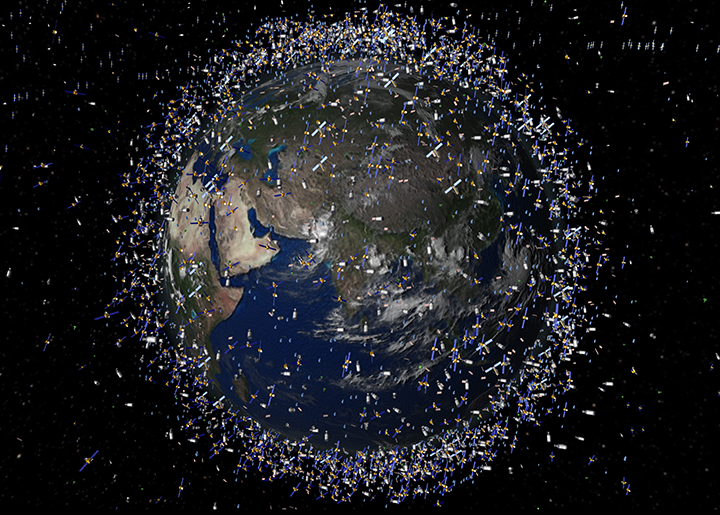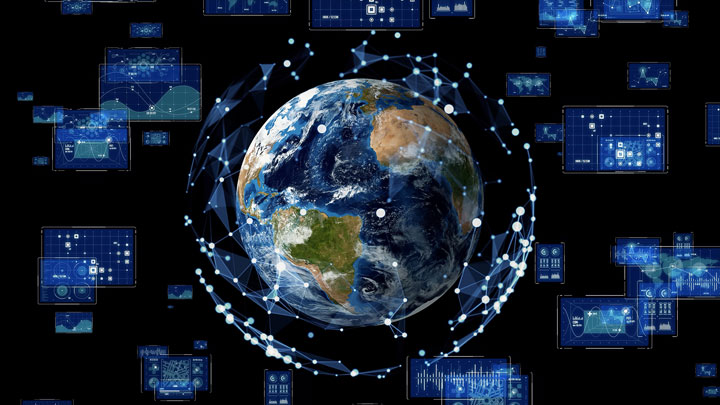Space will be around for a long time. But what about Earth’s use of it?
Constellations spoke with Dr. Brian Weeden, Director of Program Planning for the Secure World Foundation about the dramatic changes in space with the growing number of satellites and commercial and government uses, and the challenges to monitor and protect the availability of space for all.
With space providing “all these great benefits and capabilities for commercial use, national security, and civil science,” Weeden said, “we need to make sure we can continue to do that into the future as we find even new and better ways to use space.”

To put the challenge into numerical perspective, he highlighted how the number of active satellites in orbit had grown from 1,200 in the early 2000’s to over 7,000 today, with tens of thousands more projected in the next five to 10 years.
Long-term sustainability thus meant managing space debris, space traffic management, satellite testing, security issues and potential conflicts in space, even the need for global data, a key tool to protect space.
Weeden said organizations like SpaceX, Starlink and OneWeb, to their credit, had done a good job of managing what’s already in orbit. But with thousands more satellites on the way, the challenge will be working out how different constellations will operate so close to each and interface, especially if each has its own autonomous maneuvering systems with potentially different decision-making criteria.
“We’re seeing the growth in debris and constellations. The problem is right in front of us. We have to improve our domain awareness and space situation awareness capabilities to deal with it.”
He defined space situation awareness (SSA) as the broader knowledge about space activities, and space domain awareness (SDA) as the more recent military term, referring to the national security angle.
Although where that line was, was getting harder to tell.
The Dual-Use Conundrum
Weeden said there was a long-running debate about capabilities that can be used for both military and peaceful civil purposes. Rockets, for example, can be used to deliver nuclear payloads but also to launch scientific satellites and astronauts, and it was extremely difficult to tell whether something was being used in one way or another.
He said new technologies, like rendezvous, proximity operations and satellite servicing, could be great for sustainability and cleaning up space, but could also have lots of potential military applications.
One approach being discussed among countries, he said, was to define responsible behaviors in space, in that it was easier to identify and monitor behaviors than trying to define whether “a certain thing or a certain technology is a weapon or is not.”
Focusing on responsible behaviors, Weeden said, tied back to the need for better global monitoring, space domain awareness and space situation awareness.
He added that it would provide the ability to say, “Oh, we see that entity operating outside of the agreed norms, outside of what we think is the responsible behavior” and that the next step could be to sanction the behavior, call it out, or take other action if it’s a military threat.
The Data Play
Up until about 10 years ago, Weeden said governments were the only real source of data because of the national security interest, and that’s who had the ability.
But now, commercial companies were playing a bigger role, and a key reason was because data was needed to protect myriad other interests, including the International Space Station, NASA science missions and more commercial activities, including licensing and oversight.

The Handoff
While the U.S. military is still the focal point for data for providing alerts on close approaches and potential collisions, Weeden said there was a “whole conversation” about what part of space traffic management would be transitioned to the Department of Commerce.
He said that Commerce is developing a set of civil SSA capabilities to take over part of the mission from the military, but that even so, no one country can do it alone. With more governments and commercial entities using space it cannot only be the U.S.
Despite all the money it spends on space, Weeden said the U.S. still struggles to have a global network that can track everything all the time, and that it was relying on data and partnerships with other countries to augment capabilities.

The discussion included the role of international coordination and cooperation, as well as the role of commercial companies to provide better data, analytics, and algorithms.
With technology getting cheaper and better, Weeden said that between the low cost of almost off-the-shelf telescopes, new ways to build radars, and the combination of software, analytics and cloud services, “it turns out you can do some pretty amazing stuff.”
Commercial SDA capabilities also helped in terms of transparency. Data from commercial and scientific organizations didn’t present the same geopolitical or national security issues as with the military, where data from sensors used to track serious threats like missiles could reveal national security interests.
It also made more data available, diversified its sources, and provided more insight into how it was being generated. That would “hopefully enable more transparency in what’s going on in space,” he added.
A Bigger Puzzle
A “pressing question of our time” Weeden said, was how to set up standards and regulations as more countries grow their use of space. He said countries were now sharing different learned experiences and best practices on how to operate to detect potential close approaches and to avoid collisions.
He said he sees it evolving a bit like how it’s done in the air traffic world, with an international organization that “sets the global standards for how aircraft operate and interact, and then each country has a national administration,” which in the U.S. is the FAA.
He said that there were some big differences between traffic management for cars, ships and aircraft compared to how things move in space with orb mechanics but that some elements of it make sense.
“In the space world, that means we need to not only talk about a set of global standards, but then have national ways to implement those.”
To hear more about the challenges to space sustainability and the new approaches to space data, technologies and international efforts, click here.
